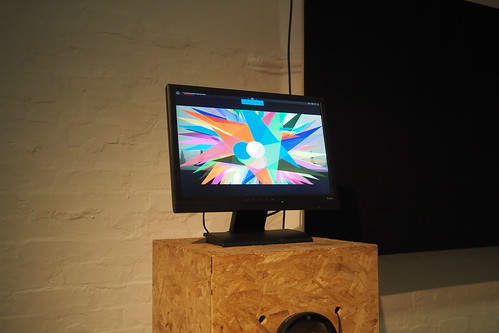The next artwork that was challenging to install was Monuments: Psychic Landscapes by Scott Benesiinaabandan.
I won’t be showing the full artwork as all of the artworks were exclusive to Bcc: and it’s up to the artists whether they show it or not. On a visual level the basic premise of the artwork is that the viewer visits a web page which loads an artwork in the form of a Processing sketch. There is a statue in the centre which becomes obscured by lots of abstract shapes over time whilst an ambient soundtrack plays in the background. At whatever point the viewer chooses they can refresh the screen to clear all of the shapes, once again revealing the statue.
On a technical level the artwork isn’t actually that difficult to install. All that needs doing is opening the web page. The difficult part is controlling user interaction.
If you’ve ever been to an exhibition with digital screen-based artworks which allow user interaction via a mouse, keyboard or even touch screen then you’ve probably seen those same screens not functioning as intended. People always find a way to exist the installation and reveal the desktop or, worse yet, launch a different program or website. So, the choice was made very early on to automate the user interaction in this artwork. After all, aside from loading the artwork, the only user interaction needed was to press F5 to refresh the page. How hard could it be?
Well, it’s very hard to do. Displaying the artwork required two main steps:
- Launch the web page
- Refresh the artwork after x seconds
Launch a web page
Launching a specific web page on startup is a relatively easy task. Raspbian by default comes bundled with Chromium so I decided to use this browser (more on that later). The Chromium Man Page says that in order to launch a webpage you just need to run chromium-browser http://example.com. Simple! There’s lots of ways to run a command automatically once a Raspberry Pi is turned on but I settled on this answer and placed a script on the Desktop, made it executable (chmod +x script.sh), and in ~/.config/lxsession/LXDE-pi/autostart I added the line @sh /home/pi/Desktop/script_1.sh. At this stage the script simply was:
#!/bin/bash
while true ; do chromium-browse --noerrdialogs --kiosk --app=http://example.com ; done
I’ll break it down in reverse order. --kiosk launches the browser but in full screen and without the address bar and other decorations. A user can still open/close tabs but since there’s no keyboard interaction this doesn’t matter. --noerrdialogs prevents error dialogs from appearing. In my case the one that kept appearing was the Restore Pages dialog that appears if you don’t shut down Chrome properly. Useful in many cases, but since there’s no keyboard I don’t want this appearing.
I wrapped all of this in a while true loop to safeguard against mischievous people who somehow manage to hack their way into the Raspberry Pi (ssh was disabled), or if Chromium shuts down for some reason. It’s basically checking to see if Chromium is open and if it isn’t it launches it. This will become very important for the next step
Refresh a web page
This is surprisingly difficult to achieve! As mentioned before, this piece requires a user to refresh the page at whatever point they desire. As we were automating this we decided that we wanted a refresh every five minutes.
Unfortunately Chromium doesn’t have any options for automatic refreshing of a web page. There are lots of free plugins that offer automatic refreshing. However, at the time that I tried them they all need to be manually activated. I couldn’t just set it and forget it. It could be argued that asking a gallery assistant to press on a button to activate the auto refreshing isn’t too taxing a task. However, automating ensures that it will always definitely be done.
At this point I looked at other browsers. Midori is lightweight enough to be installed on a Raspberry Pi. It has options to launch a web page from the command line and, according to this Stackexchange answer it has had the option since at least 2014 to refresh a web page using the -i or --inactivity-reset= option. However, I tried this and it just wasn’t working. I don’t know why and couldn’t find any bug reports about it.
It was at this point that I unleashed the most inelegant, hacky, don’t-judge-me-on-my-code-judge-me-on-my-results, horrible solution ever. What if instead of refreshing the browser tab I refreshed the browser itself i.e. close and reopen the browser? I already had a while true loop to reopen it if it closed so all I needed was another command or script that would send the killall command to Chromium after a specific amount of time (five minutes). I created another script with this as its contents:
#!/bin/bash
while true ; do sleep 300 ; killall chromium-browser ; done
The sleep command makes the script wait 300 seconds (five minutes) before proceeding onto the next part, which is to kill (close) chromimum-browser. And, by wrapping it in a while-true loop it’ll do this until the end of eternity the exhibition. Since implementing this I noticed a similar answer on the Stackoverflow site which puts both commands in a single file.
And there you have it. To refresh a web page I basically have to kill it every 300 seconds. More violent than it needs to be!
